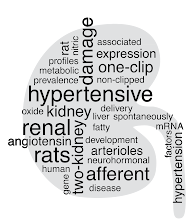"Adults aged 18–64 should do at least 150 minutes of moderate-intensity aerobic physical activity throughout the week or do at least 75 minutes of vigorous-intensity aerobic physical activity throughout the week" (WHO exercise guidelines 2010)In my previous post we saw that I managed 164 minutes per week on average over a two year period including about 20% strengthening that should be counted separately. If we work that out, it is about 132 minutes aerobic training (mostly judo) and 32 minutes strength training per week. That is enough exercise if we count judo as a vigorous activity, which seems reasonable. However, we note that it does not reach the optimum of 300 minutes of moderate-intensity or 150 minutes of vigorous-intensity exercise plus two sessions of strength training per week. At the same time it is at the top level of recreational judo. So, something is not quite right.
The first problem we will tackle is the amount of exercise. The best way of measuring physical activity is using prospective logging. That is, each participant maintains a detailed log of all activities, usually for a week. This measure corresponds well with energy expenditure measured using doubly labelled water. However, for the kind of large epidemiological studies used to base the exercise guidelines on that is too much work. Instead they rely on seven-day recall questionnaires, which basically means asking the participants what they did last week hour by hour. This is a poor estimate of actual exercise but an acceptable measure for comparing different groups of people or the same people at different time points. As expected people tend to over estimate their physical activity using the recall method. One study found an average under estimation of 40% for total duration of exercise but a massive four-fold over estimation of vigorous exercise using recall instead of logs. The result was a 70% over-estimate of exercise amount when corrected for intensity. In addition, being part of a study means that logged exercise will probably be larger than exercise during an average non-logged week. Importantly, any of the methods will probably over estimate the average amount of exercise compared to a long-term exercise log, which includes vacations, injuries, and general laziness. Anyway, this is an important part of the reason why the guidelines basically give two intervals for training amount: Less than 150 minutes/week is bad for you, and more than 150 minutes/week is good for you.
Our second scab to pick is the intensity, which is dichotomised to moderate or vigorous both in the guidelines and in the original publications. Moderate is walking or bicycling in a brisk pace, but not strenuously. Vigorously is anything more intensive than walking or bicycling, for example jogging or swimming. Behind this artificial dichotomy lies the actual activities and in research about physical activity the intensity of different forms of exercise is quantified in metabolic equivalents or METs. The number of METs that an activity has is determined by how many times the resting energy expenditure the activity consumes. Using the kind of exercise and the number of hours we can then calculate an amount of exercise corrected for intensity. This is called MET-hours, that is the number of hours of exercise at a given MET-intensity. The minimum exercise in the guidelines correspond to 7.5 MET-hours per week, and the higher goal for additional benefits is accordingly 15 MET-hours/week.
Using the Compendium of physical activities we can calculate how many MET-hours my training actually corresponds to. Judo has a MET of 10 and weightlifting 6. This works out to 22 MET-hours Judo and 3 MET-hours strengthening for a total of 25 MET-hours, which is satisfyingly above the goal for maximum benefit.
 |
| Figure 1 adapted from Leisure Time Physical Activity and Mortality: A Detailed Pooled Analysis of the Dose-Response Relationship by Hannah Arem and co-workers, JAMA Internal Medicine 6 Apr 2015. |
We can conclude that how long we, or our patients, should train depends very much on the type of training. When using these guidelines, even with correction for type of training, we should remember that they are based on reducing the risk of death. They are not meant to help you improve performance, certainly not at the serious amateur or elite level. Finally, while we can understand the reasoning behind making the guidelines as easy as possible, it would be useful to explain how to grade different forms of exercise quite early in the actual guidelines instead of leaving it to the reader to find in original sources.

